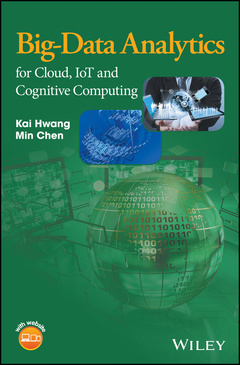Description
Big-Data Analytics for Cloud, IoT and Cognitive Computing
Authors: Hwang Kai, Chen Min
Language: English
Subject for Big-Data Analytics for Cloud, IoT and Cognitive Computing:
Keywords
kai hwang
432 p. · 17.5x24.6 cm · Hardback
Description
/li>Contents
/li>Biography
/li>
The definitive guide to successfully integrating social, mobile, Big-Data analytics, cloud and IoT principles and technologies
The main goal of this book is to spur the development of effective big-data computing operations on smart clouds that are fully supported by IoT sensing, machine learning and analytics systems. To that end, the authors draw upon their original research and proven track record in the field to describe a practical approach integrating big-data theories, cloud design principles, Internet of Things (IoT) sensing, machine learning, data analytics and Hadoop and Spark programming.
Part 1 focuses on data science, the roles of clouds and IoT devices and frameworks for big-data computing. Big data analytics and cognitive machine learning, as well as cloud architecture, IoT and cognitive systems are explored, and mobile cloud-IoT-interaction frameworks are illustrated with concrete system design examples. Part 2 is devoted to the principles of and algorithms for machine learning, data analytics and deep learning in big data applications. Part 3 concentrates on cloud programming software libraries from MapReduce to Hadoop, Spark and TensorFlow and describes business, educational, healthcare and social media applications for those tools.
- The first book describing a practical approach to integrating social, mobile, analytics, cloud and IoT (SMACT) principles and technologies
- Covers theory and computing techniques and technologies, making it suitable for use in both computer science and electrical engineering programs
- Offers an extremely well-informed vision of future intelligent and cognitive computing environments integrating SMACT technologies
- Fully illustrated throughout with examples, figures and approximately 150 problems to support and reinforce learning
- Features a companion website with an instructor manual and PowerPoint slides www.wiley.com/go/hwangIOT
Big-Data Analytics for Cloud, IoT and Cognitive Computing satisfies the demand among university faculty and students for cutting-edge information on emerging intelligent and cognitive computing systems and technologies. Professionals working in data science, cloud computing and IoT applications will also find this book to be an extremely useful working resource.
About the Authors xi
Preface xiii
About the Companion Website xvii
Part 1 Big Data, Clouds and Internet of Things 1
1. Big Data Science and Machine Intelligence 3
1.1 Enabling Technologies for Big Data Computing 3
1.2 Social-Media, Mobile Networks and Cloud Computing 16
1.3 Big Data Acquisition and Analytics Evolution 24
1.4 Machine Intelligence and Big Data Applications 32
1.5 Conclusions 42
Homework Problems 42
References 43
2. Smart Clouds, Virtualization and Mashup Services 45
2.1 Cloud Computing Models and Services 45
2.2 Creation of Virtual Machines and Docker Containers 57
2.3 Cloud Architectures and Resources Management 65
2.4 Case Studies of IaaS, PaaS and SaaS Clouds 77
2.5 Mobile Clouds and Inter-Cloud Mashup Services 88
2.6 Conclusions 98
Homework Problems 98
References 103
3. IoT Sensing, Mobile and Cognitive Systems 105
3.1 Sensing Technologies for Internet of Things 105
3.2 IoT Interactions with GPS, Clouds and Smart Machines 111
3.3 Radio Frequency Identification (RFID) 119
3.4 Sensors, Wireless Sensor Networks and GPS Systems 124
3.5 Cognitive Computing Technologies and Prototype Systems 139
3.6 Conclusions 149
Homework Problems 150
References 152
Part 2 Machine Learning and Deep Learning Algorithms 155
4. Supervised Machine Learning Algorithms 157
4.1 Taxonomy of Machine Learning Algorithms 157
4.2 Regression Methods for Machine Learning 164
4.3 Supervised Classification Methods 171
4.4 Bayesian Network and Ensemble Methods 187
4.5 Conclusions 200
Homework Problems 200
References 203
5. Unsupervised Machine Learning Algorithms 205
5.1 Introduction and Association Analysis 205
5.2 Clustering Methods without Labels 213
5.3 Dimensionality Reduction and Other Algorithms 225
5.4 How to Choose Machine Learning Algorithms? 233
5.5 Conclusions 243
Homework Problems 243
References 247
6. Deep Learning with Artificial Neural Networks 249
6.1 Introduction 249
6.2 Artificial Neural Networks (ANN) 256
6.3 Stacked Auto Encoder and Deep Belief Network 264
6.4 Convolutional Neural Networks (CNN) and Extensions 277
6.5 Conclusions 287
Homework Problems 288
References 291
Part 3 Big Data Analytics for Health-Care and Cognitive Learning 293
7. Machine Learning for Big Data in Healthcare Applications 295
7.1 Healthcare Problems and Machine Learning Tools 295
7.2 IoT-based Healthcare Systems and Applications 299
7.3 Big Data Analytics for Healthcare Applications 310
7.4 Emotion-Control Healthcare Applications 322
7.5 Conclusions 335
Homework Problems 336
References 339
8. Deep Reinforcement Learning and Social Media Analytics 343
8.1 Deep Learning Systems and Social Media Industry 343
8.2 Text and Image Recognition using ANN and CNN 348
8.3 DeepMind with Deep Reinforcement Learning 362
8.4 Data Analytics for Social-Media Applications 375
8.5 Conclusions 390
Homework Problems 391
References 393
Index 395
Kai Hwang, PhD is Professor of Electrical Engineering and Computer Science at University of Southern California, USA. He also serves as an EMC-endowed visiting Chair Professor at Tsinghua University, China. He specializes in computer architecture, wireless Internet, cloud computing and network security.
Min Chen, PhD is Professor of Computer Science and Technology, Huazhong University of Science and Technology, China. His work focuses on IoT, mobile cloud, body area networks, healthcare big-data and cyber physical systems.

